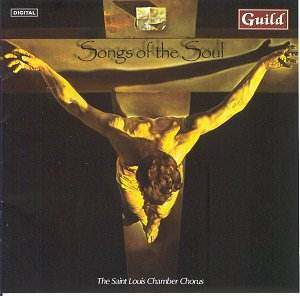Carlos Surinach was
born in Barcelona and his studies at
the Barcelona Conservatory were followed
by periods of study Düsseldorf
Conservatory, Cologne Hochschule, and
Berlin's Prussian Academy. He moved
to the USA in 1951. His principal claim
to fame is as a composer for the dance;
being used by both Martha Graham and
the Joffrey Ballet.
Surinachís music is
characterised by his sense of melody
and a strong rhythmic vitality. His
choral piece, Canciones del Alma,
reflects this and it is easy to see
why his music was popular with choreographers.
Canciones del Alma consists of
four settings of the poetry of St. John
of the Cross, the 16th century
Spanish mystic. St. John used the language
of earthly love to describe his visions
of divine love.
Surinachís choral pieces
reflect this passionate language and
mix Spanish, flamenco-influenced rhythms
and melodies, with other vibrant influences.
The closest parallel that I can think
of is with Ginasteraís choral settings
of the Lamentations of Jeremiah, another
work written by a Latin composer in
exile in the USA.
The enterprising American
choral group, the St. Louis Chamber
Chorus, under its British conductor
Philip Barnes, has made Surinachís Canciones
del Alma the centrepiece of an enterprising
programme based around the poetry of
St. John of the Cross.
Alan Ridoutís O
Flame of Love so Living sets St.
Johnís poetry in the translation by
Roy Campbell. Ridout had a long association
with the choir of Canterbury Cathedral
and he successfully re-creates St. Johnís
passionate intensity in a form suitable
for an English cathedral. The St. Louis
Chamber Chorus successfully capture
the rather English rapture of the piece,
but I would have liked a little more
freedom in the soprano line cantilenas.
Here, and in the other English pieces,
the choir did not really make enough
of the words.
Roy Campbellís translations
of St. John of the Cross are also used
in Geoffrey Burgonís But have been
found again. The piece was written
in 1983 for the combined choirs of the
Southern Cathedrals Festival in Chichester.
I did not find this piece as memorable
as some of Burgonís other work. Its
resolutely chordal but rich texture,
interspersed with solos, did not really
appeal to me. Perhaps the eight-part
layout needs the larger choral forces
and space that the Festival could have
brought to it.
Conductor Philip Barnes
has also added two more settings of
St. Johnís poetry, this time by young
composers with whom the choir has a
continuing relationship. The St. Louis
Chamber Chorus has an enviable track
record of performing contemporary music.
Sasha Johnson Manning (a pupil of Roger
Steptoe) has been commissioned by the
chorus to write a Requiem sequence.
Her Romance VI is from this work
and is an eloquent setting of St. Johnís
words; I look forward to hearing the
whole thing. Similarly adept is Aunque
es de Noche by the New Zealand-born
composer Clare MacLean (a pupil of Peter
Sculthorpe).
Although not a setting
of St. John of the Cross, Carl Ruttiís
An den Geist sets a Rilke poem
which has a similar atmosphere.
To these contemporary
pieces, the choir adds a group of motets
by St. John of the Crossís great contemporary
Tomas Luis de Victoria, though in fact
Victoria set none of St. Johnís poetry;
the motets used here set biblical texts.
The choir vary their tone for this earlier
music, but I found their performances
interesting rather than ideal. I would
have preferred a smaller group singing
with a more direct, focused, open sound.
The recording of Iste Sanctus
struck me as being a little too sibilant.
Neither Ridout nor
Surinach is well represented on CD and
this disc would be worth acquiring for
these pieces alone. But the performances
from the St. Louis Chamber Chorus are
entirely creditable. The group would
seem to be entirely voluntary and consists
of between forty and fifty singers.
Their approach works
well in Ridoutís English cathedral-style
piece but in the Surinach I could have
wished for just a little more Latin
bravura, something that does not come
easily to Anglophone choirs. However,
the choir makes a fine, warm sound and
are very responsive to Surinachís highly
coloured rhythms. Only occasionally,
in the more complex passages, did I
wish for a little more clarity of texture
from the choir, but this certainly did
not mar my enjoyment.
My only real complaint
is the way that the CD has been organised.
The Surinach pieces have been spread
across the disc interspersed with music
by other composers. This never really
allows the music time to make an impression.
Robert Hugill







